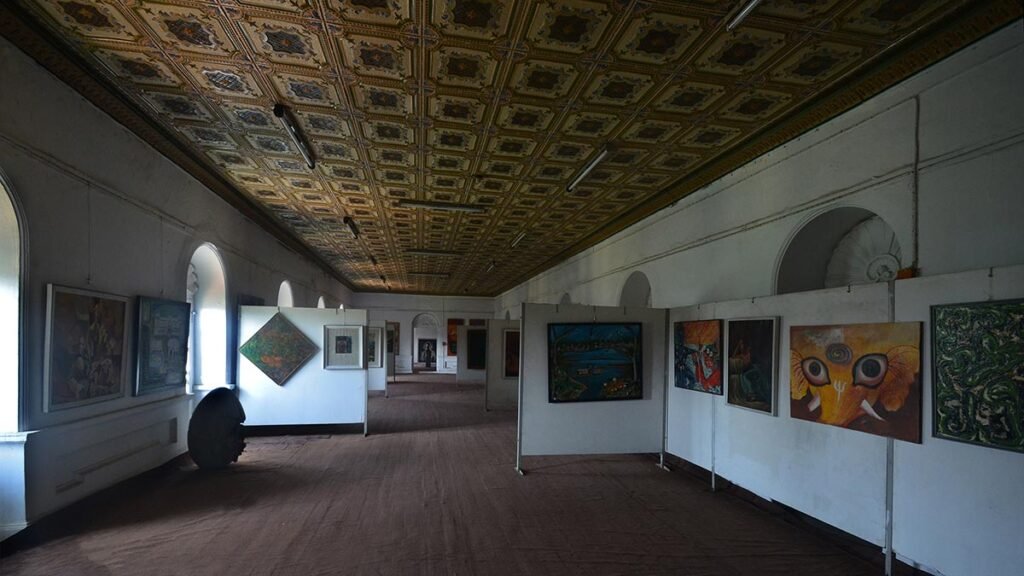A grand art exhibition titled “National Exhibition of Fine Arts,” which is taking place at the Nepal Academy of Fine Arts in Naxal, is an important event. As a regular visitor to such national annual exhibitions at NAFA for many years, I would like to dwell on the historicity and current developments of exhibitions and related activities.
In art exhibitions, management and use of space are dominant factors. Architectonic forms play a crucial role in this. Some architecturally known spaces, like old palaces and similar buildings, have been used for art exhibitions. Few sites have been permanently used, while others are temporarily utilised to display art.
Using old palaces as permanent galleries is a common practice in Europe and the Indic region. These palaces are converted into museums and permanent sites for exhibition in India. The Salar Jung Museum of Hyderabad and its art collections are quite impressive. The art exhibitions in the Victoria and Albert Museum in London remain vivid in my mind. The great Louvre museum of Paris has a palatial history, as it was a royal residence.
Nepal also has a unique history of using palatial buildings for museums. Bhaktapur and Patan museums speak about the relationship between the old houses of monarchs and their current use as museums. Although we can also mention Basantapur Durbar, the space is not used as a regular exhibition site.
The use of a palatial building built by Bhim Shamsher Jang Bahadur Rana in 1929 for his wife Sita, known as Sita Bhawan, in Naxal, Kathmandu, has become familiar as the centre of exhibitions. It was used as an exhibition space and, to some extent, as a building to preserve some artworks. This building, known by the acronym NAFA, a site for placing or exhibiting fine arts, played an essential role for many years until it was devastated by the Gorkha earthquake in 2015. According to the Chancellor of the Nepal Academy of Fine Arts, Naradmani Hartumchali Kalang, the retrofitting of the building, currently underway, will restore it once again for housing arts and facilitating occasional exhibitions.
At the moment, the temporary shades built on the open space of this property have become sites of exhibition. Though it was not planned, as far as I know, by any architects and connoisseurs, the building evolved as a centre of exhibitions out of necessity. Being part of several exhibitions, interart interactions and review sessions, I was familiar with the unique relationship between art and the architectonic space of the Sita Bhawan. Its interiors—large and small rooms, vestibules, attic and corridors became exhibition sites, especially at the time of the National Exhibition of Fine Arts. Different exhibitions of art, photography and other interart activities like bringing poets and painters together also took place in that space.
We rehearsed plays and staged short dramas in the milieu of the arts. I remember a short play we performed at the gallery to protest the demolition of the Bamiyan Buddha (two monumental Buddhist statues in the Bamiyan Valley of Afghanistan) by the Taliban. We also completed the rehearsal of a play called “The River Stage” directed by Arun Gupto there and moved the play to the bank of the Bagmati River. The gallery, the architectonic structure, became a centre of fixed art exhibitions and also performative artistic activities that emanated from there. The sudden disappearance of the whole structure was a blow to all those engaged in art activities related to painting exhibitions, performative and installation art works and poetry readings.
What I appreciate, however, is the continuity by those holding responsible positions at the Nepal Academy of Fine Arts. One could discuss this by closely examining their activities. But in retrospect, I see more things to appreciate than to criticise regarding the Academy of Fine Arts’s activities.
A careful perusal of the catalogues that Devendra Kumar Kafley (Thumkeli), member secretary of Nepal Academy of Fine Arts, gave me at my request revealed that a new era in the management of art exhibitions in the country has begun. Catalogues from the last several years, including those from the NAFA period, have been an essential source of information for me when writing reviews of artworks. A big and comprehensive catalogue would be the principal text. This time, too, an extensive catalogue of images of artworks in different media and genres with minuscule descriptions of the exhibitions of paintings is available.
I was not quite excited to see the quality of the artworks printed in the catalogue and displayed at the exhibition. A problem regarding art education, experiments and new techniques is that despite easier access to educational opportunities and means or resources of art making, the overall quality of several highlighted artworks still falls short of your expectations. But I appreciate the artists’ thrusts of experimentation and desire to create a combination of forms and motifs.
Separate art catalogues of the art exhibitions of the seven states, Bagmati, Madhesh, Gandaki, Lumbini, Karnali and the Far West, show various themes and styles. Notably, the works show a desire for art-making in these regions. I especially found the variety of the liberal choice of motifs and use of styles very beautiful. Overall, the artworks and the diversity of themes are noteworthy. However, one could easily feel that more work remains to be done to bring the art to a desired level of consummation.
In the end, onlookers and connoisseurs would easily feel and become convinced that art’s centrality is challenged by where you are practising, karma and the availability of resources. Artists’ mobility transcends the limitations of space. But my suggestion to the Academy is in order: Explore more indigenous heritage and styles of artworks and bring them to light through exhibitions and encouragements.

